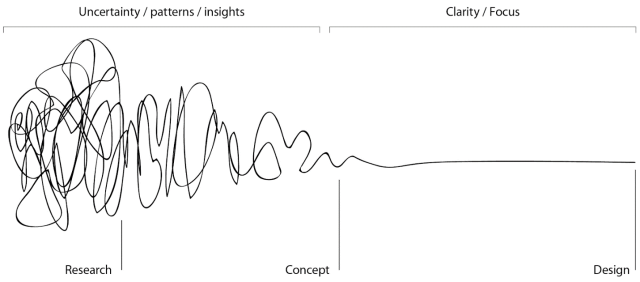Yumi Liang ‘18 and Vanessa Ganaden ’18 took some time out from their busy lives to teach current CSUF Entrepreneurship students about design thinking and how it relates to entrepreneurship. Design thinking is something that both of them learned about as University Innovation Fellows and as founders/leaders of Student Innovation Collective and they are using it in their jobs and in the roles as members of the CSUF Entrepreneurship Alumni Advisory Council. But, what is design thinking all about?
Simply put, design thinking is a powerful process innovator use to figure out how to solve problems. According to Vanessa, “Synthesizing is the act of making sense of what we have learned during the interview phase. What is the user saying, doing, feeling? One tool that we use to synthesize this data is the HMW statement. This method was developed at Procter and Gamble in the 70’s and popularized by IDEO. With this technique, you take notes in the form of a question beginning with the words ‘How Might We…?’
“It might seem unnatural to ask questions this way since we’re used using the word “Why” instead. Using “why” generally leads to very broad conceptual statements, whereas using “how” would generally lead to specific actionable statements. So even though we don’t talk like that in real life and writing it down in sticky notes might seem silly, but the open-ended, optimistic phrasing forces us to look for opportunities and challenges rather than getting bogged down by problems, or worse, jumping into solutions too soon.”

In their talk, Vanessa and Yumi lead students through this process. For them, design thinking is a very visual medium, one in which the people participating in the process are challenged to create visual representations of their proposed solutions to the problem being faced.
It’s a fascinating thing to watch; all of these university students, intently drawing out ideas with crayons and putting together basic prototypes with Playdoh, and then showing each other their creations. But, what may look like arts and crafts time for the uninitiated, is one of the most critical parts of the design thinking process.
In their talk, Yumi and Vanessa pushed the students to focus on coming up with ideas, solutions for the problems that they were given. The relative strength or weakness of each solution didn’t matter, what mattered was that the students were exercising their creative muscles and doing things this way has the added benefit of pushing people to stop limiting themselves with any concerns about how good their ideas are and just be uninhibited in their proffered solutions, no matter how ridiculous or unworkable their solutions may ultimately turn out to be.
This kind of freeform ideation session is great for teams who are working on new solutions, in other words: entrepreneurs.

Yumi and Vanessa worked with the students for almost an hour and at the end Yumi summed up the five-step process that is design thinking this way:
- Human-centered design: Empathizing with the person or people you are designing for, and feedback from users, is fundamental to good design.
- Experimentation and prototyping: Prototyping is not simply a way to validate your idea; it is an integral part of your innovation process. We build to think and learn.
- A bias towards action: Design thinking is a misnomer; it is more about doing than thinking. Bias toward doing and making over thinking and meeting.
- Show don’t tell: Creating experiences, using illustrative visuals, and telling good stories communicate your vision in an impactful and meaningful way.
- Power of iteration: The reason we go through this exercise at a frantic pace is that we want people to experience a full design cycle. A person’s fluency with design thinking is a function of cycles, so we challenge participants to go through as many cycles as possible—interview twice, sketch twice, and test with your partner twice. Additionally, iterating solutions many times within a project is key to successful outcomes.
“We believe that innovation is not an event, but a mindset, which can be learned and developed. It’s about changing habits and behaviors when understanding and defining problems, brainstorming, and problem-solving. That’s design thinking in a nutshell,” added Vanessa.
And here are some photos from this event that we think you might enjoy!

Photo courtesy of Vanessa Ganaden 
Photo courtesy of Vanessa Ganaden 
Photo courtesy of Vanessa Ganaden 
Photo courtesy of Vanessa Ganaden 
Photo courtesy of Vanessa Ganaden
CSUF Entrepreneurship
We are dedicated to helping the next generation of entrepreneurs develop the skills that they need to compete locally and globally. The CSUF Entrepreneurship program does many things,
